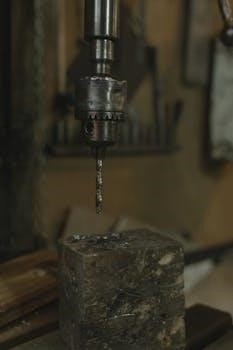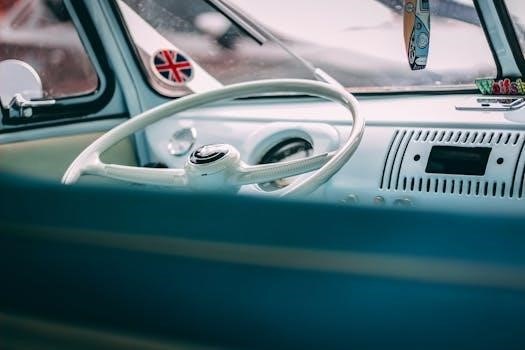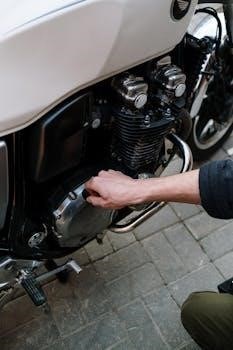Groeneveld Auto Greaser Manual⁚ An Overview
This manual provides a comprehensive look at Groeneveld automatic greasing systems. It aims to offer insight into the systems’ operation, capabilities, and maintenance. It includes technical data on various system components and serves as a guide for users seeking information about Groeneveld greasing systems.
Groeneveld automatic greasing systems are designed to enhance operational efficiency, reduce downtime, and extend the lifespan of equipment through precise and timely lubrication. These systems are engineered to deliver the correct amount of grease to all connected lubrication points automatically, eliminating the need for manual greasing. This automated approach ensures consistent lubrication, even in the most demanding operating conditions. Groeneveld systems are rigorously tested to ensure reliable performance and longevity. They are designed with an emphasis on minimizing operational costs while maximizing productivity. The company offers both single-line and twin-line systems to accommodate different application needs. Groeneveld systems aim to streamline maintenance and improve overall equipment reliability. They provide a solution to prevent premature wear and tear, leading to reduced repair costs. These systems are applicable across various industries, including transportation, construction, mining, and agriculture. They are built to withstand diverse operating environments. Groeneveld systems represent a commitment to improving equipment uptime and efficiency through advanced lubrication technology.

Groeneveld Twin System⁚ Operation and Principles
The Groeneveld Twin system is a dual-line automatic greasing system specifically developed for use with NLGI class-2 grease, addressing the limitations of other systems when using this type of lubricant. It operates by utilizing two main lines that alternate in delivering grease to the lubrication points, ensuring efficient and consistent lubrication. This system’s design is crucial for handling class-2 grease effectively, ensuring the grease reaches all required points without blockage. The Twin system is engineered to overcome the challenges associated with using thicker greases, offering a reliable method for automatic lubrication. It ensures that the connected grease points of the vehicle or machine are automatically lubricated with the precise amount of grease at the right moment. The system is designed to provide long operational life and error-free operation. The Twin system’s operation is based on a progressive distribution of grease, where one line pressurizes while the other returns, ensuring a constant supply. This principle allows for a continuous and reliable greasing process. The system is designed to be robust and dependable under extreme operating conditions, providing a long-lasting solution;
Groeneveld SingleLine System⁚ Operation and Principles
The Groeneveld SingleLine system is an automatic greasing system designed to provide efficient lubrication using a single main line. Unlike the Twin system, the SingleLine system uses one line to deliver grease to all lubrication points sequentially. The system’s operation is based on a progressive method, where each point receives grease one after the other. This setup is effective for various applications, ensuring that grease is distributed to each point. It provides an effective method for automatic lubrication and is designed to be reliable and robust. The SingleLine system is constructed to provide a long operational life and minimize errors during operation. The principle behind the SingleLine system is to deliver the correct amount of grease to each point in a sequence, which is controlled by the system’s components. The system’s simplicity contributes to its reliability and ease of maintenance. It works by utilizing pressure from the pump to push the grease through the main line, then through the metering valves to each lubrication point. The system is designed to provide a consistent greasing cycle, ensuring that all connected points receive adequate lubrication.
System Components⁚ Pumps, Reservoirs, and Control Units
The Groeneveld automatic greasing system comprises several essential components, including the pump, reservoir, and control unit. The electric plunger pump is a vital part, responsible for delivering grease from the reservoir to the lubrication points. The pump often includes an integrated grease reservoir that stores the lubricant, ensuring a continuous supply. The reservoir is designed to hold enough grease for extended periods, reducing the need for frequent refills. The control unit, typically integrated with the pump, manages the greasing cycles. It includes a database that allows users to set parameters such as lubrication frequency and the amount of grease to be dispensed. The control unit often features a display for monitoring and adjustment. These components work together to ensure the automatic greasing system operates efficiently and effectively. The pump delivers the grease, the reservoir stores it, and the control unit manages the entire process, making sure that each lubrication point receives the right amount of grease at the right time. The components are designed to work together to provide reliable and consistent lubrication.

Greasing Cycles and System Functionality
Groeneveld automatic greasing systems operate through precisely controlled greasing cycles, ensuring that all connected points receive lubrication at optimal intervals. The system’s functionality is centered on the pump, which delivers a metered amount of grease based on predefined parameters set by the control unit. The greasing cycle begins with the control unit signaling the pump to initiate lubrication. The pump then draws grease from the reservoir and pushes it through the lines to the distribution blocks. These blocks ensure that each lubrication point receives its designated amount of grease. The cycle can be programmed to occur at specific time intervals or based on machine operation. The frequency and duration of the greasing cycle are adjustable to match the specific needs of the application. The system is designed to eliminate the need for manual greasing and ensures continuous and consistent lubrication which is vital for maintaining equipment performance and extending its lifespan. The system provides a precise and reliable method to prevent wear and tear from lack of adequate lubrication. This automated process significantly reduces the need for manual intervention, saving time and labor costs.
Technical Data of Groeneveld Greasing System Components
The technical data for Groeneveld greasing system components is crucial for understanding their performance and compatibility. The electric plunger pumps typically operate within a specific voltage range, and their flow rates are measured in cubic centimeters per minute, indicating the grease delivery capacity. The grease reservoirs come in various sizes, specifying the volume of grease they can hold. These reservoirs are designed to handle different types of grease, and their material composition ensures durability and resistance to chemical reactions. The control units have specific input/output specifications, including voltage requirements and communication protocols. The distribution blocks have precise metering parameters, ensuring each lubrication point receives the correct amount of grease. The grease lines are defined by their inner diameter and pressure ratings, crucial for the system’s ability to function efficiently. The quick couplers have specific connection types and pressure handling capabilities. The electrical wiring harness specifications include conductor sizes and insulation ratings. The signal lamps have designated voltage and current ratings. The specifications are essential for effective system maintenance and troubleshooting.
Maintenance Procedures for Groeneveld Systems
Maintaining Groeneveld greasing systems is vital for optimal performance and longevity. Regular inspection of the pump unit is crucial, checking for leaks or unusual noises. Verify the grease reservoir level and refill as needed, using the correct type of grease specified by Groeneveld. Inspect all grease lines and connections for wear, damage, or leaks, and tighten or replace them as necessary. Ensure the distribution blocks are free from blockages and are properly dispensing grease to each point. Check the control unit for any error codes or malfunctions, and consult the manual for troubleshooting steps. Verify the electrical wiring harness for any damage or loose connections. Test the system’s operation after any maintenance, making sure that each lubrication point receives the correct amount of grease. Clean all components regularly to prevent buildup of dirt or debris. Periodically check the signal lamp to ensure it functions correctly. Proper maintenance following these procedures extends the system’s lifespan and ensures reliable operation. Always refer to the specific manual for your system model.

Troubleshooting and Error Codes in Twin Systems
Groeneveld Twin systems, like any complex machinery, may encounter issues that require troubleshooting. Error codes are displayed by the control unit, and these codes provide crucial information about the problem. A common error is related to low grease levels, prompting a refill of the reservoir. Other issues may involve pump malfunctions, such as the pump not delivering grease, or the system being unable to maintain pressure. Blocked grease lines or distribution blocks can also result in error codes. Electrical faults, including damaged wiring or faulty connections, can disrupt the system’s operation. It is essential to consult the specific Twin system manual to accurately interpret error codes. The manual provides detailed troubleshooting steps, helping you to identify and fix the root cause of the issue. If you are unable to resolve the problem, you should always contact Groeneveld support. Regularly checking the system can prevent many issues, and addressing error codes promptly will ensure efficient operation.
Installation of the Twin-3 Automatic Greasing System
Installing the Groeneveld Twin-3 automatic greasing system requires careful planning and precise execution. The process begins with mounting the pump unit securely, ensuring it’s accessible for maintenance. The grease lines must be routed neatly, avoiding areas prone to damage. Distribution blocks should be placed strategically to efficiently supply grease to all lubrication points. Electrical wiring needs to be connected accurately, adhering to the system’s wiring diagram. Proper grounding is crucial for safety and system reliability. The control unit, which manages the greasing cycles, is typically mounted in a protected location. Once the system is installed, it’s essential to fill the reservoir with the correct type of grease, according to the manual’s recommendations. Thorough testing is needed to confirm that grease is reaching all intended locations. The installation manual provides step-by-step instructions, making the process straightforward when followed carefully. It’s always advisable to consult with a trained technician for complex installations, to ensure optimal performance and longevity of the system.
Groeneveld System Applications and Industries
Groeneveld automatic greasing systems find wide application across numerous industries, enhancing equipment reliability and reducing maintenance costs. In the transportation sector, these systems are invaluable for trucks, buses, and trailers, ensuring consistent lubrication of critical components. The logging industry benefits from the robust design of Groeneveld systems, which withstand harsh conditions and keep heavy machinery operational. Mining operations depend on these systems to lubricate excavators, loaders, and other equipment, minimizing downtime in demanding environments. The construction industry utilizes them on heavy machinery like cranes and bulldozers, maintaining smooth operation and extending equipment life. In waste management, Groeneveld systems are essential for refuse trucks and other vehicles, ensuring efficient and reliable operation. Furthermore, these systems are also used in transit, coach, emergency and automotive industries, providing essential lubrication and increasing productivity. Groeneveld’s versatility makes them a key asset for industries requiring continuous operation and reduced maintenance. Their ability to provide precise lubrication in extreme conditions further expands their application.

